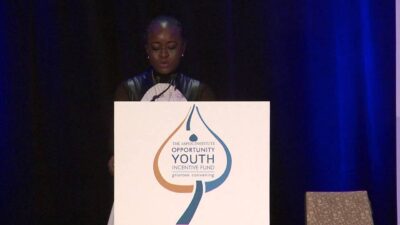
By Kathy Hamilton, Youth Transitions Director, Boston Private Industries Council, and Kristin McSwain, Executive Director, Boston Opportunity Agenda
This plenary was a breath of fresh air for those of us who have been active in the Opportunity Youth and College Completion movements. It was so heartening to hear someone center stage at a national conference finally connecting work that, despite its interconnection, can become siloed. In Boston, we play an active role in both movements. Success Boston, our college completion initiative, is a seven-year-old, cross-sector, collective-impact, initiative with a programmatic component that provides postsecondary persistence coaches to 1,000 Boston Public Schools graduates at local colleges. At the same time, several local HSE programs have adopted the Back-on-Track model, following HSE graduates into college with academic and social supports. We are using both models as a foundation for the Boston OY work.
When Aspen first funded the Boston Opportunity Youth Collaborative it was natural for us to imagine community college-to-career as one of our Opportunity Youth pathways. We believe that the most scalable strategy for OY and urban first-generation college students in general is through community colleges; Pell covers full cost of tuition and fees, or close to it, and Pell is currently one of the most broadly available public funding sources for low-income young adults. In this context, it was refreshing to hear Lili Allen give voice to the view that the two movements need to connect in her introduction of the plenary session.
The challenge is that community colleges have not always been ready for this mission. As Michael Collins noted, the focus on completion and student support is new. From the 70’s through the 90’s, the focus for community colleges was on being accessible for all. It is only in the past decade that, through initiatives like Achieving the Dream and the Talent Dividend, advocates, private funders, and government have begun to focus on completion. For us, it is important that the Opportunity Youth movement views community college reform as a critical strategy for allowing low-income youth and youth of color access to career pathways that articulate with well-paying, high skill employment.
We were also very inspired to hear about the bold and radical changes that Chancellor Cheryl Hyman made to the City Colleges of Chicago. By creating five colleges each aligned with a different industry focus and basing both the alignment and programs of study on labor market data, she made a strong statement on the role that community colleges can play in preparing residents for skilled employment.
Chancellor Hyman’s clear focus on improving completion, transfer, remediation and college enrollment for HSE and SEL students within this context was remarkable. To do it with stackable credentials and contextualized curriculum for math and English is quite impressive. Adult education providers and occupational program leaders have reported that both youth and adult learners engage much more readily in curriculum contextualized with the industry. Stackable credentials help maintain momentum and motivation to finish longer courses of study by providing certification for shorter units of mastery.
Our outstanding question, “is it too good to be true?” All these major changes at once! Though some might question whether such a complete transformation was possible, the increase in graduation rates, from 7% in 2010 to 17% at present, is so tremendous that for now, we’ll drink the Kool-Aid with Chancellor Hyman.
Our enthusiasm for Chancellor Hyman’s changes is that they are the changes we wished for our own community colleges when we first got involved with the OY movement. We are lucky that our two local community colleges have embraced the vision with us, and we were proud to have Clea Andreadis, Associate Provost of Bunker Hill Community College, on the stage as well. Bunker Hill has been working to align majors with jobs and career pathways. Perhaps even more importantly, BHCC has been working to accelerate students through the remedial phase. The college has piloted Accuplacer boot camps, clustered classes and piloted a program where the high school GPA can substitute for the Accuplacer. The college is willing to make changes, but as with all large institutions, the momentum of movements around them is critical to helping to drive those changes.
Our OY theory of action is that if we can help more low-income youth enter and complete community college, with some life and career coaching, we will dramatically increase the employment rates and income levels of populations who have been marginalized, especially the African-American and Latino communities, and immigrant communities. For that to happen on a broad scale, we need more college leaders like Chancellor Hyman to envision and execute big changes, and we need collective movements in both the college completion space and the OY space to come together to help shape that vision.
Check out the video of the plenary session, “Postsecondary Pathways: Leveraging Community College Innovations For Opportunity Youth” at the OYIF April 2016 Convening.